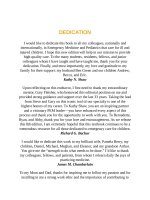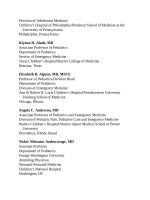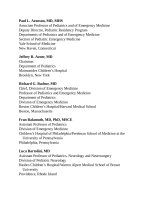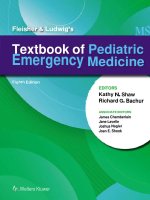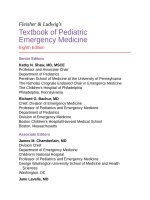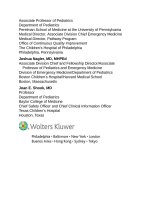Pediatric emergency medicine trisk 0331 0331
Bạn đang xem bản rút gọn của tài liệu. Xem và tải ngay bản đầy đủ của tài liệu tại đây (102.4 KB, 1 trang )
programs with formalized dispatch procedures to include up-to-date weather
information and assistance in flight risk-assessment decisions. Although there is
not a singular intervention or assessment tool that will guarantee risk-free air
transport, accreditation by the CAMTS demonstrates adherence to the safety
standards proposed for the air medical transport industry.
Vehicle Safety
Accidents involving ground ambulances are tragically common. In these
accidents, the rear compartment of the vehicle is an extremely dangerous place.
Every patient must be safely restrained in the vehicle with shoulder and body
straps, in a position that minimizes further injury and protects the airway;
however, this can pose a significant challenge with pediatric patients. Current
guidelines for the safe transport of children in ground ambulances have been
published by the National Highway and Traffic Safety Administration
( ).
Every ambulance should have the capacity to secure a child or infant safely. If
the patient is an infant and his or her medical condition permits, the use of an
approved child safety seat (CSS) should be encouraged in a forward facing seat
without an airbag. However, these are not available in most ambulances and do
not allow for ease of continuous monitoring. In some ambulances, there is a seat
in the rear of the vehicle that can be opened into a CSS that may be appropriate.
For infants and small children who are to be secured on the ambulance cot, there
are techniques that can be used to make this practice as safe as possible to reduce
the chance of another injury if the vehicle is involved in an accident either using a
commercial car seat in accordance with manufacturer guidelines or a commercial
device approved for medical transport ( Fig. 11.9 ). New products are available,
many of which have been crash tested to establish their safety capabilities, that
can safely secure a child to the ambulance cot, such as a restraint developed by
Ferno (Wilmington, Ohio) ( ). These
devices can be used for children too large to fit in a CSS or as an alternative to a
CSS.
The transport provider must take great care to ensure that the patient is
properly attached to the cot, and that the child’s head, torso, and pelvis are
appropriately secured to prevent injury in an accident. It is important to keep in
mind that many of these products may not have established crashworthiness, and
the degree of protection they provide is unclear. The family’s own car seat, if able
to be secured properly in the ambulance, may be an excellent choice for
noncritically ill patients without special needs. This also encourages a safe

